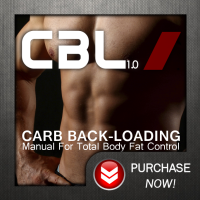My first book, The Carb Nite® Solution, is enjoying a second surge in sales because I’m learning how to promote myself and my work. This is and always will be my weak point because I don’t want to dress up my knowledge with glitter and lace and make it all pretty and palatable. I prefer dealing with the cold, steely truth. (Okay, you got me, the cover of Carb Nite is a bit effeminate, but in my defense women buy millions more diet books than men.)
 Danielle before Carb Nite®
Danielle before Carb Nite®Carb Nite is not Carb Back-Loading™ and the two utilize different metabolic processes for their effectiveness. I suppose one could argue that Carb Nite is a type of Carb Back-Loading or that Carb Back-Loading is a generalization of Carb Nite. Well, they’d lose that argument if they chose to have it with me. The two are very different.
Carb Nite—if you’ve read the book you’ll know this—came about almost out of chance for me at a time that put me near the front of the current carb-manipulation phase of dieting science. Once I stumbled upon the effects of the diet, I sought the mechanics of it. Just like a microwave, knowing how to use it doesn’t include the knowledge of exactly how it works, and without that understanding, improvement is impossible.
That’s why many of the diets that first came out around the time of mine didn’t last long—with one notable exception, which I attribute to fantastic marketing (yes, if you hear a bit of jealousy in that last clause, you’re not insane). Who I consider at the forefront of this trend is Dr. Mario Di Pasquale with his Anabolic Diet. At the time of release, research didn’t exist to improve on the diet.
 Danielle 7 weeks after starting Carb Nite®
Danielle 7 weeks after starting Carb Nite®Another website also published a T-bag diet—or something like that—and again, without understanding their own work, the authors started accumulating suggestions from readers as to what worked for them. The diet became a hodge-podge of anecdotal advice, everyone slapped their name on it as co-creator, and its effectiveness dropped with each product you have to purchase that’s essential for the diet to work. Had they understood the body well enough (and by this time the knowledge did exist) they could have done the opposite and determined what was different about each individual from the response of their body to the diet, and left out all the expensive supplements.
Take Carb Nite. Some people don’t follow the plan exactly and get good results. Rather than rewrite the entire book each time that happens, I know my work and the body well enough that I can guess with accuracy about their daily exercise routine and maybe something about the way their parents fed them when they were 6 months old. I’m not some sort of dietary-savant: the science out there is just that good.
I hunted down all the research I needed to convince myself that I understood it before recommending it. After two years of constant research and 7000 citations, I was convinced. Once I had a solid foundation, I optimized it, tested it on focus groups, simplified it based on feedback, slapped on that pretty cover and started selling it. And that was the advent of one of the most powerful fat loss manuals ever published in my opinion.
So what is Carb Nite? It is a lowest-common denominator fat loss instruction manual with the added benefit of preserving the maximum amount of muscle. If you read, understand and follow it, you can control body fat for life, stay lean and strong with little effort. What do I mean by lowest-common denominator? If you’re a human being who needs to lose pounds of fat—the first bulbous 50 or the last parasite-like 10—without losing muscle, Carb Nite, if followed exactly, works.
 Brian Carroll before Carb Back-Loading
Brian Carroll before Carb Back-LoadingCarb Nite is my diet of choice for all of my physique athletes from bodybuilders to bikini to figure. It even strips the fat off the hips. I do tweak it as necessary and further optimize it over what I published. (I can’t put all my knowledge out there; I have to keep some of the juicy stuff for myself.)
One thing Carb Nite is not good for (not yet anyway) is gaining muscle. I have tried multifarious methods to grow muscle while on Carb Nite without success. I was flying blind because there was no guiding research. But now, there is newer research that might offer an opportunity of muscle growth while on Carb Nite and I’m going to give it another go.
This is where we begin the story of Carb Back-Loading. I don’t handle carbs well. I bloat like a raccoon carcass baking in the sun after one day of eating carbs…clean eating. Buddha-belly-Kiefer is a sure sign that I’m on a carb-based diet. Pretty clear then why I love Carb Nite: it’s life sans carbs, except one day a week when it doesn’t matter what I eat. I might bloat that one night, but it’s gone by the next morning. I can’t, however, build muscle while using it—back to the drawing board.
I’m always uncovering new research, stuff that spans free-living eating experiments to the molecular working of cells and sometimes several unrelated papers click and a single theme emerges. This is what happened that sparked Carb Back-Loading. Again, I studied until I was convinced it would work and how best to implement it. I don’t have the large pool of users I have with Carb Nite, but several people, including myself and some clients achieved great results. Everyone grew (even females) while maintaining their body fat levels and in some cases with men, losing body fat. Until I was confident in the results of people I work closely with, I kept Carb Back-Loading to myself.
 Brian 7 weeks after Back-Loading. His weight didn’t change, but his body fat percentage decreased
Brian 7 weeks after Back-Loading. His weight didn’t change, but his body fat percentage decreasedThe first elite athlete willing to try the plan was Brian Carroll. His results, like others, have been awe inspiring. As he talked about his approach, and as people saw the results, the cat was out of the bag. I was hesitant to move forward because I won’t say the diet or science is titanium-clad, but it’s pretty damn good and the results testify to the validity of the concept. And, so, there it is: Carb Back-Loading.
Someone proposed in the comments that I contradicted myself and other dietary plans by allowing carbs on a daily basis with Carb Back-Loading, since a main tenet of Carb Nite is to eat less than 20 to 30 grams of carbs per day. Anything more risks poor results because of how the body works metabolically.
The principles in the two diets do not contradict one another. Carb Nite is designed for rapid fat loss while preserving as much muscle as possible. It’s made for anyone who needs to lose fat. Carb Back-Loading, on the other hand, caters only to people who perform heavy resistance training. Carb Back-Loading takes advantage of circadian rhythms and the changes in muscle tissue caused by heavy resistance training to allow, as much as possible, for someone to lose body fat while increasing muscle mass or strength. Carb Nite takes advantage of weekly rhythms to attenuate the hormonal lulls that prevent fat loss during normal weight-reducing diets. Nothing contradictory here.
 Sorry, boys: this is the only trick I got.
Sorry, boys: this is the only trick I got.People get confused because many authors know their work pretty well, and not much else, making it clear in their tone that there is only one optimal diet for any and all goals. Let’s face it: it’s easy to do the same thing over and over again. But I’m not a one-trick pony. When I helped an Ironman competitor with their diet, I didn’t say, “Well, you have two options, Carb Nite or Back-Loading, which is it?” A male Ironman competitor can use all the carbs he can ingest. But I took a female marathon runner and put her on a variation of Carb Nite. Counter intuitive, you might think, but not if you know the difference between men and women during exercise. She cut a full minute from her 1 mile pace in a month. She hadn’t been able to cut even 20 seconds in over a year. She trimmed some of the tough-to-get-rid-of fat from her thighs as well…go figure.
There is no one diet that’s perfect for everyone. There’s not even one diet that’s perfect for a single person all of the time. I change my diet based on my goals. According to current research and a growing number of success stories, Carb Nite and Back-Loading stand as two of the best strategies around and I’m proud to have contributed to the development and refinement of both. Will there be better? Probably. Will I participate in the development of future plans? I sure hope so.
Is Carb Nite for you? If you are a human being trying to lose body fat and keep lean tissue, then yes. Is Back-Loading for you? If you’re a human being trying to build muscle with resistance training and add the absolute bare minimum of fat, or even lose in some cases, then yes. Are the two interchangeable for the same goals? Absolutely not.








Recent Comments